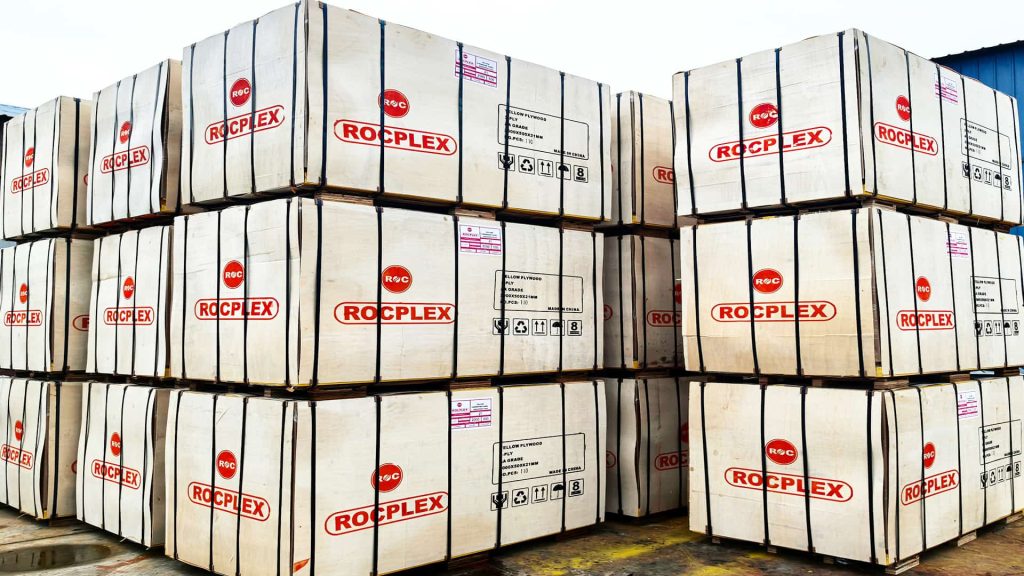3 ply form at a glance
Contractors know time rules every job. So does repeatability. 3 ply form balances both. The panel uses three bonded layers. Each layer supports the others. That design spreads stress across the sheet. Edges seal tight against water. Faces stay true under pressure. Crews move fast with lighter panels. They strip, clean, and reset without fuss. As a result, schedules hold.
ROCPLEX builds this product with strict control. Veneer moisture stays in range. Glue spread remains uniform. Press heat and time meet spec. Edges get full seal coats. We log each batch for traceability. Therefore, you can track quality from mill to site.
Why ROCPLEX leads in 3 ply form
You need panels that last more cycles. We focus on core strength and bond quality. Our layup keeps fibers aligned for load. Our resin holds under humid weather. Faces resist cement paste and abrasion. Meanwhile, weight stays friendly for manual handling. Your team lifts, sets, and locks faster.
Support matters as much as build. We ship stable sizes and consistent thickness. Provide data sheets for planning. We help you match panel counts to formwork sets also train crews on best care. With ROCPLEX, you get product and process together.

3 ply form vs film faced plywood
Film faced plywood is common on sites. It gives strong faces and neat finishes. Yet it can weigh more per sheet. Clean-up can take longer after heavy paste. Edge damage can spread into inner plies.
3 ply form brings a lighter touch. It suits fast turns and small teams. Crews strip and clean with fewer steps. Edge sealing holds up well after knocks. You also get a warm wood face that accepts release oils well. If you need lower handling strain, choose the three-ply route. For very high pressure walls, you may pair both systems by zone. That mix keeps cost down while holding finish goals.
3 ply form vs plastic formwork
Plastic formwork promises long life and easy wash. It resists water by nature. However, it can flex if support spacing goes wide. Panels can also mark with heat or hard impact. Replacement parts may cost more.
The three-ply sheet holds shape on standard centers. It takes screws and clamps well. You can trim it on site with simple tools. Repairs stay simple and cheap. When you plan many small pours, wood often wins on set speed. Plastic can suit repetitive module jobs. Yet for mixed work, 3 ply form gives broader fit.
3 ply form vs aluminum systems
Aluminum frames offer light weight and high reuse. They shine in high-rise cores. They also require set rigs and trained teams. Upfront cost runs high. Custom panels lock you into one set.
3 ply form keeps freedom on layout. You cut openings in minutes. You adjust edges without special jigs. It also works with your current clamps and walers. This saves rental costs and training time. If your project mix shifts often, wood panels protect budget and agility. Aluminum suits long runs of repeat floors. For many contractors, pairing makes sense. Use aluminum for the core. Use 3 ply form for slabs, beams, and details.
3 ply form vs steel formwork
Steel panels deliver flatness and long life. They handle high pressure with ease. Still, they weigh a lot. Lifts need cranes or more crew. Transport costs rise as well. Repairs demand welding or replacement.
The three-ply sheet offers a human scale. One or two people can carry a panel. You stage, pour, and strip without a crane. This speeds small pours and patch work. For heavy cores, rent steel where you must. For the rest, wood saves time and cash.
3 ply form vs LVL and H20 beam decks
LVL and H20 beams support wide slab tables. They are structure, not face. You still need a deck surface. Many teams lay film faced ply on top. Here, you can also choose 3 ply as the deck skin. It trims fast and seats well on the beams. The lighter weight helps table flips. When repair time comes, you swap sheets quickly. The system then returns to service the same shift.

Cost per pour and cycle math
Price per sheet never tells the full story. Cost per pour does. Start with panel price. Divide by expected reuses. Add labor to strip, clean, and reset. Add damage and waste rates. Then compare across systems.
Three-ply shines on labor. Crews move more sheets per hour. Cleaning needs less tooling. Edge fixes stay quick and cheap. Many buyers find lower cost per pour even when sheet price looks similar. ROCPLEX can model your numbers. We plug in crew size, pour area, and finish needs. You get a clear plan with realistic cycle counts.
Finish class and surface quality
Owners expect smooth concrete. Architects inspect every face. Your panel face matters here. ROCPLEX uses tight face grading. We cap knots and patch limits. We also seal edges to block water swell. This protects flatness across cycles.
Against plastic, wood gives a warmer paste bond. It reduces cold streaks in some weather. Against steel, wood avoids oil pooling. Release agents spread evenly. You still need smart care. Use clean oils. Wipe faces before storage. Stack panels flat with fillets. With these steps, you keep finish class high all season.
Safety, weight, and handling
Handling weight links to strains and slips. Lower panel weight reduces both. Crews lift with better posture. Teams move faster yet stay safer. Smaller crews can manage more area. That trims overtime risk.
Edges matter to safety as well. Sharp metal can cut gloves and skin. Thick plastic edges can snap under point load. Sealed wood edges stay kinder to hands. Your team also uses basic saws and drills. There is no need for hot works or special PPE for every cut. As always, follow site rules and lift with care.
Moisture, glue, and edges
Water tests your panel every day. Rain hits stacks. Paste brings alkaline moisture. ROCPLEX fights that with strong resin bonds. Our seal coats block water entry at edges. Our faces resist paste and stains.
Storage makes the difference too. Keep stacks on dunnage above ground. Cover the top, and leave sides to breathe. Wipe faces after stripping. Re-seal edges when cuts appear. These small steps extend life by many cycles. They also keep thickness stable. Panels then fit clamps and ties without shimming.
Sustainability and compliance
Many buyers ask about wood sources. We support legal and responsible supply. Track logs and veneers from mill to panel. We can provide certificates on request. Wood also stores carbon during service. At end of life, you can reuse offcuts in site works. You can also recover energy in approved streams. Steel and aluminum recycle well, but they demand high energy to make. Plastic recycles unevenly across markets. Wood offers a sound balance of strength and footprint.
Common site questions answered
How many cycles can I expect?
Cycles depend on care, release oils, and pour type. Many teams see strong returns with the right practice. We share care guides that raise these numbers.
Can I use 3 ply form on high walls?
Yes, within design loads and support spacing. We provide load tables for common centers. For very high pressure, combine with strong frames.
What sizes do you stock?
We ship standard slab sizes for global markets. Custom cuts are also available. Tell us your table sizes and tie layout. We will match them.
Will edges swell in rain?
Edge seal protects against rain and paste. Reseal any cuts. Store panels flat and covered. Air flow helps them dry between pours.
Can I replace film faced plywood with three-ply?
Often yes. Check support spacing and finish needs. We can propose a hybrid plan to protect budgets and targets.
Where 3 ply shuttering panel fits best
Short cycle sites gain the most. Think villas, low-rise frames, and small bridges. Teams set and strip daily. Panels move many times. Weight and quick trim mean everything here. The three-ply choice lets two people handle more area per shift.
It also shines on slab tables. Lighter decks flip with less strain. When edges chip, crews patch or trim fast. Waste falls because repairs stay simple. In contrast, plastic and steel repairs slow jobs. Those systems still have a place. For pure repetition, they can excel. For varied geometry, wood wins.

When yellow formwork panel brings extra value
Bright faces improve visibility on busy decks. Crews spot edges and hazards sooner. The color also supports brand and zone control. Supervisors can call out panel zones by color. That keeps stacks organized and safe. ROCPLEX offers stable pigments with UV care. Color stays fresh through many cycles.
Triply panel and other names
Markets use many names for one idea. Triply panel means three layers. Three-ply shuttering panel says the same. Boards for concrete formwork covers the task, not the build. Form boards and formwork boards are broad terms. No matter the name, you need proof in use. Ask for test data and field feedback. We will share both.
How to choose for each project
Start with pour type. Slabs, beams, and walls need different support plans. Then check crew size and gear. If you rely on manual lifts, weight rules. Next, map finish class. Owners may accept patching in back areas. They may demand class one in lobbies. Pick release oils and cleaning tools early. Finally, run cost per pour. We can do that with you. Numbers beat guesses every time.
Care tips that extend life
Use a soft scraper, not harsh blades. Clean soon after strip. Wipe faces before stacking. Keep stacks flat and off wet ground. Seal fresh cuts the same day. Rotate panels through zones. This spreads wear across the fleet. Train new hands on these steps. Small habits protect big budgets.
ROCPLEX supply and support
We stock core sizes for fast ship. We cut custom sets on request. Pallets arrive clean, strapped, and labeled. You get clear batch numbers. Our team answers fast with real advice. We also help plan panel counts and tie spacing. If a problem shows, we move first to solve it. That is how we keep partners for years.
3 ply form selection checklist
- Target finish class and visible zones.
- Support spacing and tie pattern.
- Crew size and lift method.
- Release agent and cleaning plan.
- Storage space and stack covers.
- Expected cycles and budget per pour.
- Data sheets and certificates on file.
Talk to ROCPLEX for your next pour
Your jobs need clear choices and steady supply. Our panels help your team pour faster. They protect finish and keep labor in line. We also back you with data and training. Send us your drawings and schedule. We will size a set that fits your plan. With ROCPLEX, you gain a partner who thinks like a builder. Let’s set your next form deck with confidence.
Post time: Nov-17-2025

